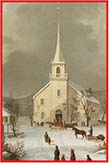American Issues  Connector: Church and State
Connector: Church and State

Students pray around a flagpole outside their school.
TRACK THE ISSUE
![]() What is the proper relationship between government and religion?
What is the proper relationship between government and religion?
The First Amendment says that government may not establish religion or interfere with the free exercise of religion. This is often referred to as “separation of church and state.” But Americans differ over how these clauses interact to prevent government from establishing religion while protecting the religious liberties of individuals. Use the timeline below to explore this enduring issue.
-
1791 Bill of Rights
First Amendment bars government involvement in religion.
-
1840s Sabbatarian Controversy
Congress debates whether to ban commerce and mail delivery on Sundays.
-
1947 Everson v. Board of Education
Supreme Court affirms separation of government and religion.
-
1984 Federal Equal Access Act
Law allows students to form religious clubs at public high schools.
-
2000 Mitchell v. Helms
Ruling allows private schools to receive federal funds for educational materials.

A church of the early 1800s
DEBATE THE ISSUE
Should prayer be allowed in public schools? One controversial topic in the church-state debate is the issue of prayer in public schools. Current law prohibits public school-sponsored prayers. Some Christians believe this ban violates their right to practice their beliefs.
“We’re deeply religious…. And we believe that prayer in school is a necessity because, although yes, my children say blessings at home and pray at home and they learn to do that at church, most of their waking hours are spent in school. So why shouldn’t they be able to pray, on the intercom, anywhere.”
—Pat Mounce, high school parent, Pontotoc, Mississippi
“I’m a Catholic and I hope a devout one, but I think that the public school classroom is no place for me to try and impose my world formula for prayer on children who don’t share it, and for that very reason, I don’t want my children in a public school classroom to be exposed to someone else’s religion or formula.”
—Senator Phillip A. Hart, Michigan
 TRANSFER Activities
TRANSFER Activities
- Compare What views do Mounce and Hart share? On what point do they differ?
- Analyze How do you think each of these two speakers would have reacted to the issue of outlawing commerce on Sunday?
- Transfer Use the following Web site to see a video, try a WebQuest, and write in your journal. Web Code: neh-6802




